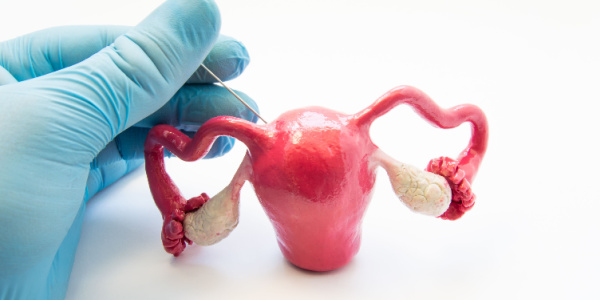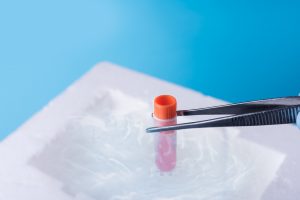Menopause is a natural stage of life that every woman is confronted with sooner or later. While some women are still fertile in their early 50s, others experience premature menopause before the age of 40. Most women agree that the menopause has its advantages and disadvantages. Some are happy about the end of menstruation and no longer having to worry about an unplanned pregnancy, others are afraid of possible hot flushes, mood swings and other unpleasant symptoms. What for some is a short and barely noticeable phase in their lives can lead to permanent changes and discomfort for others.
A new paradigm regarding the biological processes of menopause is attracting the attention of scientists. The key question is: Can menopause be delayed in healthy women so that they can extend their childbearing years – and perhaps even prevent some of the health risks and unpleasant symptoms associated with declining estrogen levels? These questions can be controversial: some people believe that this research could lead to life-changing benefits for women, while others view menopause as a biologically determined stage of life that should not be pathologized by medical science.
Mathematical Model Provides Information on How Long Menopause can be Postponed
At Yale School of Medicine (YSM), Kutluk Oktay, MD, PhD, an ovarian biologist and director of the Molecular Reproduction and Fertility Preservation Laboratory, recently added a new chapter to this discussion by publishing research on various possible outcomes when menopause is delayed in healthy women by freezing ovarian tissue. Oktay, who in 1999 developed and performed the world’s first ovarian transplant using cryopreserved tissue for a patient with a medical indication, envisions a future in which healthy women could use this procedure of freezing tens of thousands of eggs in ovarian tissue to delay menopause by several decades – or even prevent it altogether. For the first time in the history of medicine, researchers now have the possibility of delaying or preventing menopause altogether.
Using data from hundreds of previous ovarian cryopreservation and transplantation procedures and molecular studies of the behavior of ovarian follicles in ovarian tissue, Oktay and his colleagues created a new mathematical model, published in the American Journal of Obstetrics & Gynecology, to predict how long the procedure could delay menopause under different circumstances in healthy women.
Ovarian Cryopreservation can Significantly Delay Menopause in Most Women Under 40
Since Oktay performed the first successful transplant using cryopreserved tissue, ovarian tissue cryopreservation has been used successfully in cancer patients to preserve their fertility before treatments, which can often permanently damage the ovarian reserve and trigger menopause. In this outpatient procedure, a surgeon laparoscopically removes the entire ovary or layers of the outer part, which contains hundreds of thousands of dormant, immature eggs (known as primordial follicles).
These tissues are then stored in sealed containers after being frozen using a special procedure and cooled down to minus 160 degrees Celsius. Freezing ovarian tissue using this special process preserves it for later use. At a certain point in time – usually years later – the surgeon implants the thawed tissue back into the patient, either laparoscopically or using a simple procedure developed by Oktay, in which the tissue is placed under the patient’s skin while intravenous sedation is administered. Within three to ten days, the transplanted tissue is reconnected to the surrounding blood vessels and restores ovarian function in about three months.
The recently published mathematical model, which focuses on healthy women undergoing ovarian tissue cryopreservation, takes into account several factors, including the age of the patient undergoing the procedure, which plays an important role in how long menopause can potentially be delayed. The younger the person is, the more eggs she has, and the higher the quality of those eggs. The model refers to women between the ages of 21 and 40. Beyond the age of 40, the data shows that it is unlikely that the procedure will delay menopause for a woman with an average egg reserve, but this may change in the future with the development of more efficient freezing and transplantation methods.
The model also provides information about the ideal amount of ovarian tissue to be removed. The more tissue a surgeon removes, the longer the procedure can delay menopause. However, if too much tissue is removed, this can lead to an early menopause. This model provides the researchers with information about the optimal amount of tissue that can be removed from a person at a certain age. The model also takes into account the healing process after the surgeon has returned the removed ovarian tissue to the patient. During this healing process, some of the primordial follicles are lost. Studies in animal models have shown that up to 60% of primordial follicles do not survive after transplantation, and only 40% are viable. With newer technologies, he believes surgeons can achieve a survival rate of up to 80%. With further improvement of the procedure, the hope is to eventually achieve a survival rate of 100%. The model therefore assumes a survival rate of between 40 and 100%.
In addition, the research results suggest that menopause can be delayed even longer if parts of the removed tissue are transplanted over several procedures. For example, the team’s model shows that returning one-third of the outer part of the ovary in each of the three procedures delays menopause longer than returning all of the tissue in a single procedure. Based on the model, Oktay predicts that ovarian cryopreservation can significantly delay menopause in most women under 40. And in women under 30, the procedure may even prevent menopause altogether. Since many women lose their ability to conceive earlier than they would like, ovarian cryopreservation may be an attractive option for them. The ability to freeze ovarian tissue and transplant it later offers a way to extend the fertile lifespan.
Can Women also Benefit Health-Wise from Delaying Menopause Through Cryopreservation?
Delaying menopause through ovarian cryopreservation may also have certain health benefits associated with a later age of menopause. According to new research by Oktay and his colleagues, about 11% of women experience late-onset natural menopause – or menopause after the age of 55. Studies show that women who enter menopause later live longer and have a lower risk of a range of diseases, including cardiovascular disease, dementia, retinal disease, depression and bone loss. However, it remains unclear whether a later menopause actually reduces these health risks. Oktay hypothesizes that these risks could also be mitigated in healthy women who delay menopause by cryopreserving ovarian tissue, and if the risk of such chronic diseases is reduced in healthy women who undergo this procedure, it could be a significant benefit.
As part of ongoing research, Oktay and his team are studying the outcomes of healthy women who have opted to delay menopause through this procedure. Publication of these studies is still a long way off, but in the meantime the mathematical model provides a starting point to test the feasibility and potential benefits of bringing forward menopause in healthy women.







